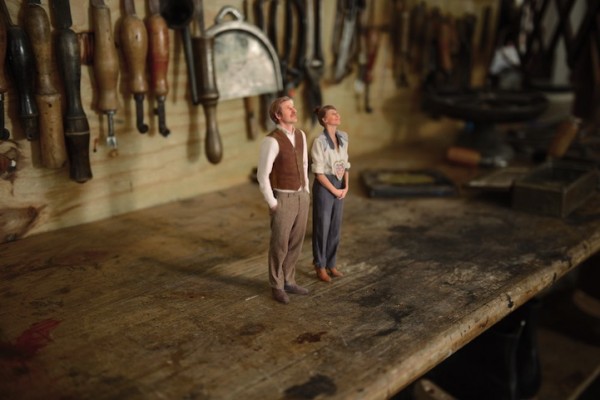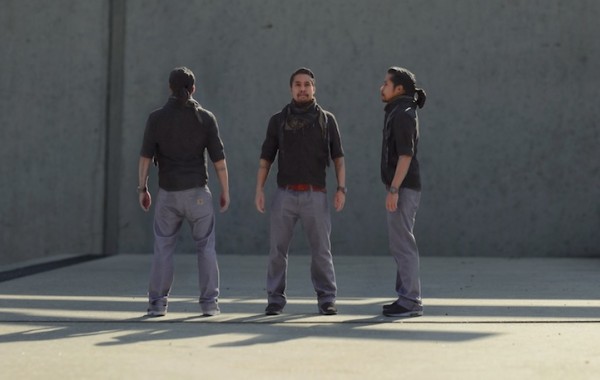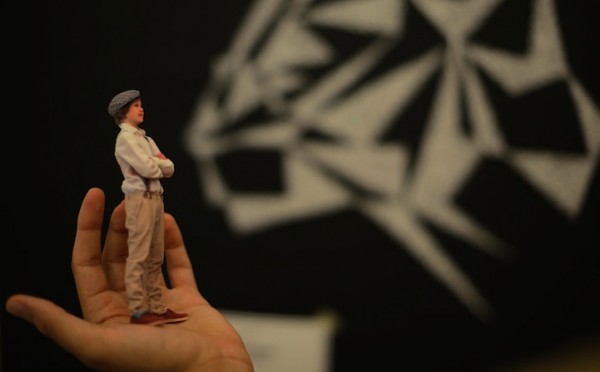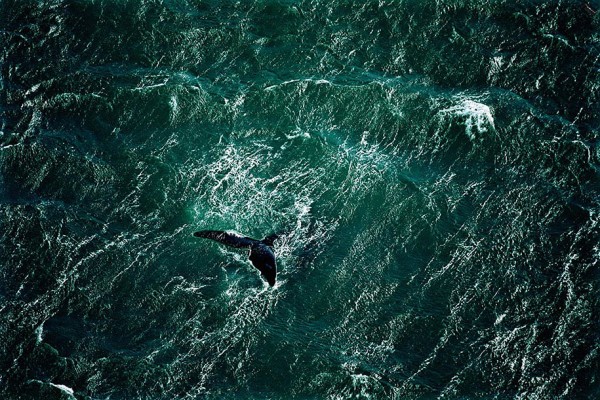

GemMan
-
Content Count
250 -
Donations
$0.00 -
Joined
-
Last visited
-
Days Won
4
Posts posted by GemMan
-
-
-
Citrus growers use predator wasp to fight disease threat
Invasive species expert Mark Hoddle coaxes a vial of predatory wasps to the tip of a citrus branch infested with psyllids. The tiny wasps become parasites to a species of psyllid that has been spreading a deadly bacteria in citrus trees throughout the Southland.
California citrus farmers import a parasitic wasp from Pakistan to battle citrus greening, a disease threatening their groves.
August 4, 2013
Pesticides haven't worked. Quarantines have been useless. Now California citrus farmers have hired an assassin to knock off the intruder threatening their orchards.
The killer-for-hire is Tamarixia radiata, a tiny parasitic wasp imported from Pakistan.
Its mission: Rub out the Asian citrus psyllid, which has helped spread a disease that turns citrus fruit lumpy and bitter before destroying the trees.
The pest is wreaking havoc in Florida's 32 citrus-growing counties. In California, it's been detected in nine counties, most of them south of the commercial growing areas in the Central Valley. Farmers are hoping the Tamarixia wasp can help keep it that way.
The wasp, which flew coach in a carry-on bag from Pakistan's Punjab region, is a parasite half the size of a chocolate sprinkle. But it kills psyllids like a horror movie monster, drinking their blood like a vampire. The female wasp can lay an egg in the psyllid's belly. When it hatches, it devours its host.
The wasp "is going to be our number one weapon to control to Asian citrus pysllid," said Mark Hoddle, an invasive species expert at UC Riverside, who, over several trips, brought legions of wasps to California.
"We have no other choice except to use this natural enemy or do nothing. And the 'do nothing' option is unacceptable."
Watch: Unleash the wasps
A tiny parasitic wasp imported from Pakistan is used to attack nymphs of Asian citrus psyllids.
So far, Hoddle and his teams have released more than 75,000 wasps across the Southland to beat back the disease, known as huanglongbing or citrus greening. The malady was first detected in California last November in a backyard citrus tree in Hacienda Heights.
The disease can lie dormant for a few years before tests are able to detect it, so experts suspect other trees are already infected.
"We're looking for a needle in the haystack before it sticks us," said Joel Nelsen, president of the California Citrus Mutual, a trade group.
The U.S. Department of Agriculture has enacted quarantines in nine states, including Florida, Texas and California. The quarantines prohibit interstate movement of citrus trees and require labeling of citrus nursery stocks from areas where greening has been detected.
In California, the quarantine covers nine counties. The northern border of the quarantine region had stretched across Santa Barbara, Ventura, Los Angeles and San Bernardino counties, but on Wednesday, agriculture officials expanded it to 178 square miles in Tulare County where the psyllid was detected.
That recent discovery raises the fear that the pest is creeping into prime citrus growing areas. It could threaten California's $2-billion industry, which accounts for about 80% of the U.S. fresh market citrus production. Florida's citrus is primarily processed for juice.
Since 2010, California growers have spent about $15 million yearly to fight the psyllid. Much of that money goes toward massive detection and awareness efforts. That's on top of millions the federal government and state Department of Food and Agriculture have kicked in.
The psyllids don't kill citrus trees. They're merely the agent that spreads huanglongbing. An infected psyllid acts much like a dirty syringe flying from tree to tree, feeding and depositing a bacterium each time it unfurls its stinger.
Whether the killer wasp can bring the psyllid to heel remains to be seen.
Florida growers imported a strain of the wasp from Vietnam, but it proved ineffective. The predator never took hold, partly because there was not enough genetic diversity needed to establish a population, researchers said. Some Florida growers now are looking to develop genetically modified citrus that would be immune to greening — a controversial strategy that could turn off consumers.
In California, farmers are betting on the wasp — and on Hoddle and his wife, Christina. The UC Riverside entomology experts have spent their careers helping control invasive species around the world.
Since late 2011, they have been releasing the wasp, mainly in Los Angeles County. Agriculture officials halted pesticide spraying in the county this year, partly because it proved too cumbersome. Six out of 10 citrus trees in the county grow in backyards, making large-scale containment efforts difficult.
"This is ground zero for our war," Hoddle said.
The goal is to reduce the psyllid population and provide a line of defense between urban areas in Southern California and the commercial growing zones.
The Hoddles and teams they've trained have been going neighborhood to neighborhood releasing thousands of wasps and tracking the parasites' success.
The Hoddles conducted extensive testing to make sure the wasp wouldn't disrupt California's ecosystem, considering that past efforts at introducing non-native species have gone awry.
Tiny predatory wasps just before release on a citrus tree in Pico Rivera.
To satisfy the federal government's concerns, the Hoddles quarantined the wasp for 18 months and performed several experiments to see whether it would attack native species. Time after time, the wasp attacked only the Asian citrus psyllid. After the researchers submitted a 60-page report to the Department of Agriculture, the release program was green lighted. The wasp poses no danger to humans or pets, Hoddle said.
On a recent weekday, the Hoddles drove to Pico Rivera. It was their third trip to the area, where most of the homes have unfenced front yards, providing easy access.
The back of their Toyota SUV contained their tools: a cooler with vials of wasps, a clipboard with log sheets and equipment to inspect citrus trees.
At each tree on their route, the procedure was the same: For one full minute, they circled the tree, counting the psyllids and looking for evidence that the wasp was preying on them. The psyllid, about the size of an aphid, is easy to spot.
The first few trees were unremarkable, and the Hoddles wondered whether the wasps had survived the winter.
Still, "It's good. We're finding clean citrus," Hoddle said before walking another yard.
It's still too early to say the wasp releases are working, Christina Hoddle said. To confidently conclude that the wasp is slashing the psyllid's numbers, at least three years of data are needed.
While the team is only about 18 months into the effort, some areas have shown promise. At some release sites, the psyllid population has been drastically cut.
At one of the last homes they visited, the Hoddles saw just how densely the psyllids can congregate. After getting permission to enter a fenced yard, they were dismayed to see one small, shrubby tree crawling with psyllids.
The pest had blanketed some of the branches in a sugary wax, an excrement of young psyllids.
The tree would need more aggressive treatment. Instead of one vial of wasps, Mark Hoddle reached for two.
Entomologist Christina Hoddle releases a vial of predatory wasps in a citrus tree.
He carefully opened the first one, placing a small tree branch directly inside the vial's opening.
The wasps wasted no time. "They're all over these guys!" he said. "They're going to town."
After a few minutes, he tied the vial to the tree with a wire. The last wasps would wander out on their own later.
As their work wrapped up for the day, the Hoddles headed back to their car.
They would be visiting another neighborhood the next day. The battle would be a long slog, with no certain outcome.
"California has been preparing for this day," Mark Hoddle said. "It'll be hard to fault the citrus industry. I think they've done everything possible.
-
Things You Should Not Do While Driving
When using a metered entrance ramp, vehicles in the carpool lane do not need to stop. Similarly, vehicles NOT in the diamond lane also do not need to stop.
If, at any time, you have witnessed a green light, it is okay to proceed through the intersection, regardless of the current color of the light.
The shoulder becomes a lane if you are driving a Porsche.
If you paid more than $60,000 for your car, you automatically have the right of way, regardless of the situation. This is especially applicable in parking lots.
Drive as quickly as possible through parking structures. Pass any open spot by at least four car lengths before backing up to claim it. Disregard the angry mob that has formed behind you.
Get to know your horn. Use it as often as possible.
While driving on the freeway and talking on your cell phone, alternate between 45 and 100 MPH. This is especially effective if driving in the fast lane.
Every lane is the suicide lane.
Always set the alarm to its most sensitive setting before leaving your car in a parking ramp.
During rush hour, drivers should pass the time by reading Deepak Chopra or L. Ron Hubbard, and practice inner peace when cut off by a Mercedes.
If you miss your exit, no worries. Just cut across six lanes of traffic and drive over the divider. If you really weren't supposed to cross it, they would make it out of concrete instead of icicle plants.
For parking purposes, all SUVs are compact cars. Honest.
To calculate the proper speed limit on the freeway, subtract your age from 100. Double this number if your car has dual exhaust. Conversely, add your age to 100 if you are driving on the 101 or suffering from a midlife crisis.
If a cop attempts to pull you over, give chase. You won't get away, but it's guaranteed you'll make live TV. Towards the end of the chase, be sure to throw random items out of your window. It will give the reporters something to talk about on the 4, 5, 6, 8, 9, 10, and 11 o'clock news.
Never use your turn signal, unless of course you are on the freeway with no intention of merging.
Totally disregard on-coming traffic.
If there are already three cars stopped at a four way stop, accelerate immediately. Otherwise, one of those cars might go ahead of you!
Rush hour at the 101/405 interchange is from 5 AM to 11 PM, except around holidays that create airport traffic, when hours are extended to 3 AM.
Never Carpool.
Take full advantage of your right to U-turn. Laugh aloud at people from other states who turn around in driveways.
In case of rain, immediately pull over. You can not drive in any sort of precipitation.
While driving uphill, do not down shift. While driving downhill, ride your brakes.
When parking on a hill, turn your wheels out, set the emergency brake, remove radio face, enable the alarm, and put The Club on your steering wheel.
On narrow canyon roads, feel free to use the center divider as a passing lane. -
German Subs: Sunken WWI U-Boats a Bonanza for HistoriansBy Frank Thadeusz
British archaeologists recently discovered more than 40 German U-boats sunk during World War I off the coast of England. Now they are in a race against time to learn the secrets hidden in their watery graves.
On the old game show "What's My Line?" Briton Mark Dunkley might have been described with the following words: "He does what many adventurers around the world can only dream of doing."
Dunkley is an underwater archeologist who dives for lost treasures. His most recent discoveries were anything if not eerie.On the seafloor along the southern and eastern coasts of the UK, Dunkley and three other divers have found one of the largest graveyards in the world's oceans, with 41 German and three English submarines from World War I. Most of the submarines sank with their crews still on board, causing many sailors to die in horrific ways, either by drowning or suffocating in the cramped and airtight submarines.
Several U-boats with the German Imperial Navy are still considered missing today. Lists provide precise details on which of the U-boats the German naval forces had lost by the time the war ended in November 1918.
But it was completely unclear what had happened, for example, to UB 17, under the command of naval Lieutenant Albert Branscheid, with its crew of 21 men, or where the 27-member crew of UC 21, used as a minelayer and commanded by naval Lieutenant Werner von Zerboni di Sposetti, had perished.
Securing British and German Heritage
But now things have changed.
Dunkley and his team of divers found UB 17 off England's east coast, near the county of Suffolk. UC 21 sank nearby. The fate of many other submarines, especially those that had suddenly disappeared in the last two years of the war, can now be considered known.
All of the sunken U-boats are relatively close to the coast, at depths of no more than 15 meters (about 50 feet). The diving archeologists will undoubtedly find the remains of sailors with the German Imperial Navy inside the wrecks. In the language of archeology, such finds are referred to as "disaster samples." In any case, the divers will be searching for signs of the crewmembers that died inside the U-boats.
"We owe it to these people to tell their story," says Dunkley. He works for English Heritage, a public body that is part of the Department for Culture, Media and Sport. Its primary mission is to secure Britain's cultural heritage.
The British could see it as a peculiar irony of history that these measures are now benefiting the heritage of their former enemy. Since the Germans attacked civilian targets in World War I, British propaganda derisively referred to the submarines as "baby killers."
"Many have forgotten how successful the German U-boat fleet was for a time," says Dunkley -- an assessment that is by no means intended to glorify the German attacks. In fact, one of the goals of the most recent English Heritage project is to remind people that, although they might be more familiar with submarine warfare from World War II, the ships also caused considerable devastation in the previous world war.
A Slowly Embraced Weapon
Indeed, it had practically vanished from popular memory that the Germans caused great losses to their main enemy, Great Britain, in World War I through targeted torpedo strikes against the royal merchant navy. At the beginning of the war, there were only 28 U-boats under the supreme command of Kaiser Wilhelm II, a tiny number compared to the Allied fleet.
At first, many political decision-makers in Berlin were unclear about exactly how the military devices, which were still novel at the time, could be used. Grand Admiral Alfred von Tirpitz had such a low opinion of the importance of the steel diving vessels that he even referred to them as a "secondary weapon."
An operations order signed by Kaiser Wilhelm on July 30, 1914 also assigned a secondary role to the U-boats at first. Under the order, they were to be used primarily to engage hostile ships in naval battles with the Imperial High Seas Fleet, which had been upgraded at considerable cost.
But after a German U-boat sank three English armored cruisers, an unbridled enthusiasm erupted in the German Empire for this still relatively untested form of naval warfare. A large number of volunteers signed up for submarine duty, even though serving in the cramped cabins was practically a suicide mission at the time, especially in comparison with the types of underwater vessels used in World War II and, even more so, today's submarines.
The conditions inside the boats were claustrophobic and extremely hot. There were cases in which entire crews were wiped out when a torpedo misfired. Likewise, since aiming torpedoes was still such an imprecise science, the submarines had to come dangerously close to enemy warships. And if spotted, they became easy prey: Early submarines moved through the water so slowly that enemy warships could easily take up pursuit and sink the attackers, either with depth charges or by ramming. In fact, some 187, or almost half, of the 380 U-boats used by the German navy in World War I were lost.
A Race Against Time
Dunkley and his colleagues examine the wrecks with ultrasound sonar devices they wear on their wrists like watches. The devices allow them to measure wall thickness and determine the extent to which corrosion has already eaten away at a ship's hull.
Measures to secure the vessels are urgently needed, says Dunkley. Since the U-boat graveyard at sea is gradually disintegrating, time is of the essence for the archeologists. Under the strict guidelines of the UNESCO Convention on the Protection of the Underwater Cultural Heritage, the World War I wrecks sitting on the seafloor are currently not even considered archeological artifacts deserving special protection.
The disintegrating war machines are currently just shy of the 100 years required to attain this status. For this reason, Dunkley's team is trying to wrest as many secrets as possible from the wrecks in the coming months.
In cases where mines or torpedoes have torn large holes into the vessels, the archeologists can even peer inside. When this is not the case, robotic vehicles will cut open the hatches of the steel coffins and go inside.
"We divers only approach the boats with great caution. Venturing inside would definitely be extremely dangerous," Dunkley says.
It is hard to determine how almost a century of lying in place, as well as sedimentary deposits, have changed the structural integrity of the wrecks. If a U-boat turns over as a result of the divers' movements, its narrow corridors could become deathtraps.
The treatment of the crews' remains is also complicated. By law, the sites are considered inviolable gravesites. Nevertheless, the archeologists don't want to miss the opportunity to try to recover other signs of the erstwhile sailors in the underwater crypts. "Perhaps we'll find a cup or a sign with a name on it," Dunkley says.
Attacking and Sinking in Groups
The marine archeologists were struck by the fact that sometimes two or three German U-boats were found lying in close proximity to one another. For historians, this serves as evidence of a certain German combat strategy in an especially drastic phase of the U-boat war.
In February 1917, the Imperial Navy had altered its strategy and was now torpedoing and firing guns at British commercial ships on a large scale. The Royal Navy reacted by providing the freighters with warship escorts, as well as using airships and aircraft to spot enemy submarines from above.
German military strategists devised a plan to break up these massive convoys: attacking the naval convoys with several U-boats at the same time. But the strategy was difficult to implement because it was very difficult to coordinate such complex maneuvers at the time.Historians are divided over whether the convoy system ultimately saved the United Kingdom from defeat or whether it was the United States' entry into the war on April 6, 1917.
Before then, the British had relied on creativity to fend off U-boats and other enemy ships. The hulls of their own ships were painted with confusing patterns designed by artists at the Royal Academy in London. But there is no historical evidence to prove that this measure saved even a single ship from the German torpedoes.
-
 1
1
-
-
Turbine-powered motorcycle aiming for 400 mph land speed record
By Gary Gastelu
Published July 17, 2013FoxNews.com-

James Toseland with the 52 Express (52 Express/Facebook)
-
 52 Express/Facebook
52 Express/Facebook -
 52 Express
52 Express
A turbine-powered two-wheeler built to break the motorcycle land speed record made its public debut this past weekend at the Goodwood Festival of Speed in the U.K.
The “52 Express
 ” will be driven by two-time Superbike World Champion James Toseland when it goes for the mark next year.
” will be driven by two-time Superbike World Champion James Toseland when it goes for the mark next year.The record currently stands at 376.363 mph, set by Rocky Robinson in 2010, but Toseland and company have their eyes on breaking 400 mph.
Instead of riding on top of it like the Honda and Ducati bikes he used to race, Toseland will be sitting inside of an enclosed cockpit in a reclined position more like an F1 driver.
The Rolls Royce Gem turbine -- originally designed for helicopters and rated at 1,000 shaft horsepower in that application -- is placed behind the driver and sends power to the rear wheel via belt drive.
A Mickey Thompson pneumatic tire rated at 500 mph is fitted there, while a roller-coaster style cast polyurethane tire is used at the front, because no traditional tire small enough to fit can handle the type of speeds the 52 Express is aiming for.
Both will be bench tested on a custom rig to determine if they are up to the rigors of the run, while the shape of the bodywork has already been evaluated at the University of Derby for stability and proper engine breathing to help keep the turbine from stalling at speed.
But even though maximum velocity is the goal, project manager Robin Richardson -- a veteran of the supersonic Thrust SSC land speed record-holding team -- says they’ve aimed to build a safe vehicle first then make it fast, rather than try to do it the other way around.
To this end, the front and rear sections of the 52 Express carrying the engine and fuel tank are designed to break off in the event of an accident, while a safety capsule surrounding the driver and fitted with a fire suppression system offers the chance of surviving a high speed crash; a very clear and present danger the speed record world was reminded of this past Sunday when Bill *****W was killed during an attempt to break 300 mph on a sit-on bike at an airstrip in Maine.
As for where the 52 Express will make its record attempt, the team is still deciding between the Bonneville Salt Flats in Utah and South Africa’s Hakskeen Pan, where another team is planning to go for overall land speed record of 763.035 mph in the four-wheel, jet and rocket-powered Bloodhound SSC later this year.
-
-
7 clever uses for ordinary smartphone features
By Kim Komando
Published July 21, 2013You've heard the old saying, "Familiarity breeds contempt." When it comes to technology, I'm not sure if contempt is the right word. Perhaps it's better to say, "Familiarity breeds indifference." Well, it's time to bring back some of the wonder. I've rounded up seven amazing things you didn't know your smartphone could do.
- 1Rewind the past
"Did I hear that right?" We've all had moments where we're sure we misheard something someone said. Or someone said something hilarious and we wish we had a recording.
Well, now you can pull audio from the past. No, I'm not saying your phone can time travel - yet.
Heard
 for iPhone is always recording using your smartphone's microphone. At any time, you can save audio from up to 5 minutes in the past.
for iPhone is always recording using your smartphone's microphone. At any time, you can save audio from up to 5 minutes in the past.Don't miss your baby's first words or the name of that important client again.
- 2Help you sleep better
Many people blame technology for their lack of sleep. Staring at a screen confuses your brain about the time of day. Your phone buzzes from incoming text messages and wakes you up throughout the night.
Well, technology can be a solution as well. Give Sleep Time
 for iPhone and Android a shot.
for iPhone and Android a shot.You start by placing it on your mattress before you go to bed. The phone's accelerometer detects your movements during the night and figures out your sleep pattern.
The app's alarm gently wakes you up during the lightest part of your sleep cycle. You can avoid that groggy feeling that makes you want to hit the snooze button.
- 3Make you aware of your surroundings
Listening to music or watching a movie on your smartphone is a great way to pass the time. It can make your morning walk or a bus ride fly by.
The downside is that many earphones block out the surrounding noise. That's great if you want to tune out the world. It's not so great if a car is honking at you or the driver announces your stop.
Awareness
 for Android and iPhone fixes that problem. It uses your smartphone's microphone to keep track of noise around you. Any sounds louder than regular background noise gets sent to your headphones.
for Android and iPhone fixes that problem. It uses your smartphone's microphone to keep track of noise around you. Any sounds louder than regular background noise gets sent to your headphones.You can hear a car honk, a bus stop announcement or your friend talking. And you won't miss a second of your music or video.
- 4Help you measure up
As my Dad always used to say, "Measure twice, cut once." Even if you're not cutting anything, measuring can prevent costly mistakes.
But you don't have to reach for a ruler or tape measure. Android users can fire up Advanced Ruler Pro
 and iPhone users can grab Visual Measure
and iPhone users can grab Visual Measure .
.Just take a picture of an object or room and then follow the directions. The app can figure out the dimensions for you. From a chair to a mansion, you can measure virtually anything.
iPhone users also have the amazing Acoustic Ruler Pro
 . This uses sound reflection to measure distances. It's similar to the way bats detect bugs and obstacles.
. This uses sound reflection to measure distances. It's similar to the way bats detect bugs and obstacles.There are two modes. If you have two iPhones, you can measure distances up to 82 feet. With one iPhone, you can measure distances just under 4 feet.
- 5Give you heart
Smartphones and tablets are on their way to becoming indispensible medical gadgets. They've already been wired with sensors to detect certain blood chemicals. MIT created an add-on, NETRA, which turns any smartphone into a portable eye tester. The list goes on.
Most of these advances are years away from being commercial or require add-ons. However, some people are doing interesting things with the smartphones they already have.
Instant Heart Rate
 for iPhone and Android uses the phone's camera to figure out your heart rate. It detects the light passing through your finger and how it changes as your heart beats.
for iPhone and Android uses the phone's camera to figure out your heart rate. It detects the light passing through your finger and how it changes as your heart beats.You can keep a log of your heart rate to track it over time.
- 6Help you prove your metal
There are plenty of valuable items that people drop every day. A simple metal detector is all you need to find them and make some extra money.
Don't have a metal detector? Don't need one. Metal detector apps for Android
 and iPhone
and iPhone have you covered.
have you covered.No, I'm not joking. Smartphones contain a compass for navigation. It's not difficult to tweak it to detect nearby metal objects.
You will need to find a comfortable way to hold your phone near the ground, however. Walking around bent over just looks odd!
- 7Prevent a lapse in attention
Time-lapse videos are amazing. You can watch natural phenomena unfold that would take too long with the unaided eye.
Time-lapse pros use expensive, high-tech equipment to get their shots. If you want to try your hand at it, however, it only takes a few bucks.
Your smartphone can make time-lapse movies no problem. Just grab TimeLapse
 for iPhone or Lapse It
for iPhone or Lapse It for Android.
for Android.You can set how frequently the camera snaps a picture. Then the app will put the images together in a movie file. You just need to tap a button.
Well, you also need to figure out a good way to keep your phone pointed where you want. There are plenty of low-cost tripod hacks people have come up with online.
If you want a premade solution, you can grab a smartphone tripod. Look at the GripTight GorillaPod from Joby ($30) or the Sony SPA-MK11 ($30).
- 1Rewind the past
-
Schoep, The Sick Dog Whose Viral Photo Touched Millions, Dies At 20, Says Owner John Unger
The Huffington Post | By Cavan Sieczkowski Posted: 07/19/2013 12:23 pm EDT | Updated: 07/19/2013 12:50 pm EDT

Schoep, the dog made famous on the Internet for this touching photo, has died at 20 years old.
Schoep and his owner John Unger made headlines last summer when local photographer Hannah Stonehouse Hudson snapped a photo of Unger and his pup wading together in Lake Superior. Unger would regularly take Schoep into the water because it was therapeutic for his arthritic body.
The photo went viral online, and millions of people were touched by the relationship between man and dog. Readers sent in thousands of dollars in donations to help pay for Schoep's treatment.
On Thursday, the news that Schoep had died was posted on Facebook. "I Breathe But I Can't Catch My Breath... Schoep passed yesterday[,] more information in the days ahead."
The post, which included a photo of a paw print in the sand, has already received more than 33,000 "likes."
"Schoep and John had an amazing relationship ... I hope that people can give John some space and privacy for now ... he just lost his best friend," Stonehouse Hudson told the Pioneer Press.
She says she understands Unger's loss because her husband died in January.
"I know what it feels like to lose a being you have shared every moment with," she said. "It's like losing a limb -- and I'm sure John is feeling that right now."
Unger adopted Schoep when he was just an 8-month-old puppy, according to the Duluth News Tribune. He had been abused by his former owner, and it took time for the pup to trust Unger. The two finally developed a bond so strong that Unger credits Schoep with saving him from a deep depression following a bad breakup.
Last year, Stonehouse Hudson told The Huffington Post that Unger "lives for this dog." The photo of the two in Lake Superior should be a lasting reminder of their love.
"I want people to identify with this photo, and remember a time when they felt safe, loved, and cared for," Stonehouse Hudson said at the time. "Then I want them to channel those feelings and pay it forward! There is way too much negativity in this world - maybe with this one photo we can start to change things just a tiny bit."
Schoep celebrated his 20th birthday on June 15.
-
Apple TV With Gesture Control? iWatch Next Year? This Week In Apple Rumors
The Huffington Post | By Timothy Stenovec Posted: 07/20/2013 9:25 am EDT

Hello, ladies and gentlemen, and welcome to This Week In Apple Rumors, our regular look at unconfirmed gossip and questionably sourced reports radiating from Cupertino. This week we heard rumors about Apple's long-awaited, yet-unnamed television, the iWatch, and, of course, possible details on the next version of the iPhone.
So without further ado, here's This Week in Apple Rumors.
Ad-Skipping, Gesture-Controlled Apple Television
There was a lot of talk this week about the TV that is said to be in development. On Monday, Jessica Lessin broke the news that Apple is working on a service that would allow people to skip TV ads, and Apple would pay the networks for the money they'd lose with fewer people watching the ads.
And on Tuesday, the Verge relayed a report from the Israeli business daily Calcalist that Apple is mulling the purchase of PrimeSense, an Israeli company that designs 3D sensors that allow people to interact with devices. PrimeSense technology is used in the Xbox Kinect. The rumored interest set off speculation that Apple could use this technology to build a TV that you control with your hands. Writing for Quartz, Christopher Mims suggests that the company's facial and body recognition technology could give an Apple TV the power to recognize who's watching, enabling the device to have customized profiles.
But the most important question: Since the Apple TV already exists, will it be called the iTV?
iWatch Watch
All eyes are on the so-called iWatch, and it would appear that Apple is moving full speed ahead on what could be one of the most highly anticipated products the company has yet developed ... if it's actually being developed. A report in the Financial Times on Sunday quoted sources who said that Apple is hiring "aggressively" for the iWatch project, and that "several dozen employees" are working on the wearable device. But there's still a long way to go: The FT reports that the iWatch "would not be ready for launch until the latter part of next year."
This news comes on the heels of recent reports that Apple has moved to trademark "iWatch" in a half-dozen countries, including Japan, Russia, Turkey and Mexico.
Slow-Motion Video
We've heard a lot about the features of the next generation of the iPhone: Will it come with a fingerprint scanner? A 12-megapixel camera? A 13-megapixel camera?!
The folks at 9to5Mac reported recently that the next iPhone -- which we'll call the iPhone 5S -- may come equipped with a camera that can record video at 120 frames per second, which would allow for sharp slow-motion video. (The iPhone 5 currently shoots video at 30 frames per second.)
"Indestructible" Liquidmetal iPhone
Jonathan S. Geller, the Boy Genius himself, predicted this week that the iPhone 5S will be made of Liquidmetal, an alloy that's two times as strong as titanium. Geller cited as evidence Apple's extension last year of a licensing agreement with Liquidmetal that takes it through 2014.
iPad Mini
It's good news/bad news for those waiting for the next generation iPad Mini: The good news is that according to a report in Digitimes, which cites "supply chain sources," the iPad's lighter and smaller sibling may be getting a Retina display and an "almost bezel-free look."
But the bad news is that version is more than a few months off: Digitimes says the new tablet won't be released until the beginning of next year, although a "lighter, thinner" iPad Mini -- without a Retina display -- may be released in time for the holiday season.
-
-
Ric Flair arrested over spousal support paymentFormer pro-wrestler Ric Flair could be arrested if he doesn't pay up more than $32,000 to his estranged wife, Jacqueline Beems.(57) || Ric Flair. File/UPI/Bill GreenblattLicense photoPublished: July 17, 2013 at 9:12 AMBy GABRIELLE LEVY, UPI.com
Ric Flair. File/UPI/Bill GreenblattLicense photoPublished: July 17, 2013 at 9:12 AMBy GABRIELLE LEVY, UPI.comA judge issued an arrest warrant for former professional wrestling champion Ric Flair for failing to pay spousal support to his estranged wife.
The Mecklenburg, N.C. judge held Flair in contempt for withholding $32,352.51 from Jacqueline Beems -- the same estranged wife who was charged and turned herself in Tuesday for harassing Flair's current girlfriend.
Flair, whose given name is Richard Fliehr, was ordered to pay Beems $4,000 per month after she filed for legal separation last year.
The wrestler can avoid jail time if he pays up -- which he said he fully intends to do as soon as Wednesday.
“The reason I didn’t pay my ex-wife the 32 grand is because my son died and I was in the hospital for a month,” Flair said. “I was in the hospital for a month with a blood clot. I didn’t go to work for three months.”
Reid Fliehr, 25, died on March 29 of a toxic combination of heroin and prescription drugs.
An attorney for Beems said she did not know where Flair is, and that the accusations that she threatened Flair's girlfriend Wendy Kidder -- in 50 texts and five voicemails, according to Flair -- are "unfounded and outlandish."
Beems was charged with a misdemeanor and released on $500 unsecured bond.
Beems and Flair have been married for three years, and just months after their wedding, Beems charged with misdemeanor assault after the couple got in a fight. Police dropped charges for lack of evidence.
-
Giant panda gives birth to twins in AtlantaZoo Atlanta's 15-year-old Giant panda Lun Lun gave birth to twin cubs Monday.(1) ||Twins giant panda cubs born at Zoo Atlanta on July 15, 2013 weigh less than 9 ounces combined. (Zoo Atlanta/Adam K.Thompson)Published: July 16, 2013 at 12:40 PMBy GABRIELLE LEVY, UPI.com | BlogA giant panda at Zoo Atlanta gave birth to twin cubs Monday, the first panda multiples born in the U.S. in 25 years.
Lun Lun, the 15-year-old Giant Panda, was in labor for about 90 minutes before giving birth to the cubs, her fourth and fifth. The sex of the cubs has not yet been revealed, and the public won't see them until late fall.
The names will be announced when they reach 100 days old, based on a traditional Chinese tradition for good luck.
Zookeepers artificially inseminated Lun Lun back in March with sperm from Yang Yang, the father of all five of Lun Lun's cubs. Until the younger cub arrived at 6:23 p.m., two minutes after its older sibling, the giant panda team had no idea Lun Lun was pregnant with twins.
Twin births do occur in the wild, but typically only one of the cubs will survive because mother will only care for one. In zoos, keepers rotate the cubs with the mother every few hours for the first few months.
Giant pandas are born tiny, and the risk of mortality is very high in the first few months. Twins face even more danger because of their smaller size -- the combined weight of the newborn cubs is just 8.6 ounces.
"This is a success we share with all of our fellow zoological organizations working to understand and protect this iconic species, and we share our joy with our local community and with our colleagues in China,” said Raymond B. King, President and CEO. “Twins are an entirely new scenario for Lun Lun, Zoo Atlanta and our animal care teams, who will no doubt be extremely busy over the next few months.”
-
U.S. prosecutors consider charges against Alberta MLA caught in prostitution stingBy Alexandra Zabjek and Jodie Sinnema, Edmonton Journal July 17, 2013 Fort McMurray MLA Mike Allen booking photo Photograph by: Supplied , Ramsey County Sheriff's Office
Fort McMurray MLA Mike Allen booking photo Photograph by: Supplied , Ramsey County Sheriff's OfficeEDMONTON - U.S. prosecutors expect to decide by Friday whether to lay charges against a Fort McMurray MLA arrested in an undercover prostitution sting in St. Paul, Minn.
City attorney Sara Grewing is still reviewing the case for “possible gross misdemeanour charges,” she said Wednesday.
“Human trafficking and the promotion of prostitution has been something that we’ve focused on. ... (The police) do stings, anecdotally, about once a month. That’s something that we’ve committed our resources to as a policy matter in St. Paul.”
While she couldn’t speak to specific details of Mike Allen’s case, Grewing pointed to a Minnesota statute that prohibits a person from engaging in prostitution or hiring someone for the purposes of prostitution in a public place. Minnesota law defines a public place to include locations such as hotel rooms and massage parlours.
Allen, elected to represent Fort McMurray-Wood Buffalo in 2012, resigned from the Tory caucus and from any committee responsibilities Tuesday. He had been in Minnesota with Calgary-Fort Conservative MLA Wayne Cao, attending the Council of State Government Midwestern Legislative Conference, and returned to Alberta late Tuesday night.
Duane Bratt, a political scientist at Mount Royal University in Calgary, said Allen’s response has been appropriate.
Even if Allen is charged or convicted, Bratt said he doesn’t know if Allen should step down as an MLA.
Alberta’s Wildrose party has called for a byelection to replace Allen. Premier Alison Redford has not commented. Guy Boutilier, who was defeated by Allen in the last election, also wouldn’t comment.
NDP Leader Brian Mason said he found the Allen situation “distasteful,” but he wasn’t prepared to join calls for his resignation.
“We should be thinking a little bit more about the family than simply trying to take political advantage,” Mason said.
Bratt said: “I would argue that drinking and driving is a much more serious offence than prostitution. I think so and I would think most people would think so.”
He compared Allen’s reaction to the incident to that of Gordon Campbell, who was charged and convicted of drunk driving in 2003 when the then B.C. premier was on holiday in Hawaii. He pleaded no contest, didn’t resign from caucus and remained as premier.
“Drinking and driving can lead to death, serious bodily harm, damaging of all sorts of other people,” Bratt said.
Minnesota officials won’t say if Allen was arrested Monday on a public sidewalk or in the privacy of a hotel room. If Allen responded to an escort agency ad and met undercover officers in a private area, he wasn’t breaking Canadian law.
“Escort agencies are sort of a grey area in Alberta, which muddies the waters completely,” Bratt said. “In my view, the most serious aspect of this was it happened while he was supposed to be working. And yes, you’re going to have free time, but the comparison with Wayne Cao, who went to a museum, is a bit striking.”
But Allen’s arrest could also be seen as entrapment by police, Bratt said.
Allen allegedly answered an ad placed by undercover police on the website Backpage.com. Police reports show Allen responded to the ad, meeting with two female undercover officers. He was arrested about 8 p.m. local time Monday under suspicion of engaging in prostitution, after allegedly agreeing to exchange money for sexual services, a police spokesman said.
“I’m not a lawyer here, but my sense is this isn’t about convicting people. This is about embarrassing people: when you start putting mug shots in the paper, that’s a pretty strong deterrent,” Bratt said.
“I think there’s a lot of social shaming and there may be some who feel ‘That could be me’ or that may be unfair. There may be some sympathy for him as well, especially as contrite as he’s been.”
Quito Maggi, who was Allen’s campaign manager in 2012, said he considers Allen a close friend. He said Allen is single with grown children.
“What I can tell you is that Mike is the most honest, genuine and kind person I have ever known,” Maggi said in an email. “I think those traits led him to do the right thing (Tuesday) and immediately resign from the caucus until the legal matter is resolved. I give him credit for that.”
Maggi said Allen’s reputation as a “hard-working and passionate advocate for Fort McMurray and Wood Buffalo … won’t be undone by a single mistake.”
He said Allen helped accelerate the twinning of Highway 63 to the northern area. The Transportation Department has yet to receive further direction on how to replace Allen as special adviser for the highway project.
“I think the people of Fort McMurray-Wood Buffalo will remember his accomplishments,” Maggi said.
But Liberal MLA Laurie Blakeman said she sees soliciting for prostitution as a serious problem.
“I feel betrayed,” Blakeman said. “I think this man made a very deliberate choice in his activities that has betrayed his caucus, betrayed all the MLAs elected, his constituents, his family and all Albertans.”
She said elected officials are representing all Albertans when travelling on government business.
“Unlike how it’s been characterized on Twitter, it is not a personal issue and it is not a temporary lapse in judgment. It is a deep ethical and moral flaw in someone’s character,” Blakeman said. “It’s a betrayal of any government talk about recognizing the seriousness against violence against women, about human trafficking, about child prostitution, about bullying.”
She said Allen was hired by his constituents and must listen to them in deciding whether or not to step down.
Grant MacEwan University political scientist Chaldeans Mensah said Allen’s actions were both a personal failure and a failure to live up to high standards expected of legislators.
“It’s not good news,” he said. “It builds on the problems the party has faced in recent months, but it’s also a personal tragedy in this case.”
Sgt. Paul Paulos said prostitution is a priority for his police department in St. Paul, Minn. The department posts photographs of people recently arrested on prostitution-related charges.
“It’s a danger to women, it’s a danger to the people offering to purchase it,” he said.
For the past eight years, the department has operated the Gerald D. Vic Human Trafficking Task Force, named in honour of an officer who was known for working with prostitutes and those at risk of becoming involved in prostitution. Vic was killed while on duty about 10 years ago.
“He broke down a lot of barriers and stereotypes, whether you’re dealing with the police or with the females,” Paulos said.
“He was a real groundbreaker to that and developed relationships and partnerships in the community. When you do that, trust develops.”
Canada’s prostitution laws prohibit communicating for the purposes of prostitution in public places, such as along roads.
“It’s basically designed to deal with women on the stroll and their johns,” said D’Arcy Depoe, head of the Criminal Trial Lawyers’ Association in Edmonton. “A lot of the time, first-time offenders are allowed to go to johns school, which is attending a course put on by city police, and they talk about the difficult that prostitutes face on the street, how many of them are struggling with drug addictions, that it’s dangerous and that it breeds violence.”
Depending on the details of the Allen case, he could face a minimum of a $1,500 US fine or a maximum of a year in low-security jail and a $3,000 fine.
-
Most-wanted fugitive caught in South Texas
Tuesday, July 16, 2013

EL PASO, TX -- State authorities say a man who was among the 10 most-wanted criminals in Texas has been captured in South Texas.
The Texas Department of Public Safety announced Monday that 54-year-old Robert Allen Kotlar was arrested at a home in El Campo, about 70 miles southwest of Houston. He was added to the most-wanted list on Thursday and captured the next day.
Kotlar was wanted on an array of charges that include assault, burglary, vehicle theft, forgery and resisting an officer. He most recently was sought for a parole violation. His arrest was the result of a tip and authorities say a $7,500 reward will be paid.
The department says so far this year 22 people named to the most-wanted list have been caught.
-
By Associated Press, Published: July 17

IDYLLWILD, Calif. — Firefighters braced Wednesday for an intense day battling a wildfire in the mountains southwest of Palm Springs that already has burned seven homes and led to the evacuation of dozens more as well as a camp serving children with cancer.
Temperatures were expected to soar as high as 105 in the area and humidity was critically low, possibly dipping as low as 1 percent by the afternoon, said Tina Rose, a spokesman for the California Department of Forestry and Fire Protection.
“I was here at sun-up and the fire was burning like it was 3 o’clock in the afternoon. That is extreme fire behavior,” Rose said, adding that the area had not burned in many years. “The slightest little spark is going to make a run and torch trees. It’s just so bone dry.”
The blaze destroyed three houses, damaged another and destroyed three mobile homes, a cabin, a garage and about a half-dozen vehicles, the U.S. Forest Service said in a statement Tuesday. Eleven outbuildings, five commercial buildings and several smaller structures also have been lost.
The wildfire started Monday between Palm Springs and Hemet, near the rural Riverside County community of Mountain Center and grew to more than 22 square miles by Wednesday morning. It was burning in thick brush and trees at an elevation of 5,000 to 7,500 feet.
More than 2,200 firefighters and 25 aircraft had the blaze about 10 percent contained.
It was mostly moving east toward the desert and away from small communities of homes, summer cabins and ranches in the San Jacinto Mountains.
Most of the damage occurred late Monday and early Tuesday as the fire more than doubled in size, but it was not assessed until later in the day. About 50 homes were evacuated along with Camp Ronald McDonald, which hosts programs for children with cancer and their families.
The fire also led authorities to close a pair of state highways and the Pacific Crest Trail. One of the highways reopened Wednesday.
-
Sanaa Lathan: Denzel Washington’s Reported Mistress Resurfaces In New Rumors

Sanaa Lathan and Denzel Washington have a complicated history, and the reported mistress of the 58-year-old actor has now resurfaced in new infidelity rumors.
Rumors have circulated this week that Denzel cheated on his wife of 30 years, Pauletta, kissing a woman he met at a house party. The strain on the relationship comes just after Denzel and Pauletta appeared on the cover of Ebony magazine together, but now has grown so bad that they reportedly spent their 30th anniversary apart.
The rumors have recalled another reported instance of infidelity. Sanaa Lathan and Denzel Washington appeared together in the movie Out of Time, and reports said they two grew to be more than friends. Despite the alleged affair, Denzel was able to squirm his way out of trouble.
“[His wife] confronted him, and once again he denied he did anything wrong,” a source told Star.
Sanaa Lathan stuck to the same story, saying she and Denzel were co-stars and nothing more.
“(The rumor) got started because the movie had a love scene with Denzel, and people took that and translated it to real life,” Sanaa said in 2006. “They said I was pregnant with Denzel’s child, and people were calling my mother, saying I’m having his baby. It’s frustrating. People are going to talk no matter what.”
For Denzel, the Sanaa Lathan situation could provide a blueprint for the current struggles. Pauletta has been firm in her support of Denzel in the past, saying she accepts the good times along with the bad.
“I live with this man. I see the down part. I see the sad part. I see every part,” she told Ebony.
Pauletta adds: “He has and knows he has stability in me as his wife. That’s what gives him strength, regardless if he misuses it. I can’t dwell on that. But I do know that gives him a great platform to go and fly.”
With rumors of the Sanaa Lathan affair fresh in mind, Denzel again denies that he cheated on his wife.
-
140 Pound Testicles Man Now Has 1 Inch Penis After Operation

Wesley Warren Jnr is furious after an operation to remove his 140 testicles reduced the size of his penis to just one inch.
Wesley decided to go through the 13-hour procedure because he was forced to wear a hoodie to support his testicles, was unable to have sex, and was in horrible pain from carrying such a heavy load.
However, Wesley has now revealed that he fears he will be unable to ever have a relationship with a woman, because he is so embarrassed by the size of his penis.
He told The Sun, “I know the majority of people are probably expecting me to express extreme happiness and glee that my life has been transformed since the sac has been removed – but it’s not as simple as that.”
Warren then added, “I do feel a great sense of comfort that the weight is no longer between my legs. It got to the point that it was a danger to my health. But when I look down at what’s here now it’s not the same as what it was. It’s totally different.”
He also went on to state, “My natural look prior to the growth is not what came out of surgery. What came out of surgery is a nub an inch long and it doesn’t get any larger. I’m grateful to have been pulled out of the fire, I was getting burned, but now I’m dealing with the first degree burns. I’m still disfigured.”
Warren admitted, “I can’t even think about getting into a relationship. It would take someone very patient or very insane to want to have me in their life.”
Warren Wesley began to suffer from the embarrassing illness in June 2008, after he squashed his genitals whilst in his sleep. After being prescribed antibiotics to reduce the injury, his testicles wouldn’t stop growing.
-
Edward B. Myers, Pennsylvania Man, Arrested For Videotaping Son Light 7-Year-Old Boy On Fire
Posted: 07/12/2013 1:47 pm EDT
A Pennsylvania man was arrested this week after police accused him of videotaping his teenage son lighting his now ex-girlfriend's young son on fire.
Edward B. Myers, 35, allegedly used a cell phone to record the incident, which occurred on May 25 at the Saxonburg, Penn., home of his then-girlfriend and her son, according to CBS Pittsburgh affiliate KDKA.
The 7-year-old victim had third-degree burns on his face and chest after Myers allegedly doused the boy's shirt in flammable liquid and watched as his 15-year-old son lit the garment on fire, reports KDKA.
Myers' two sons allegedly shot the victim multiple times with pellet-type guns, according to KDKA.
When the victim's mother came home, she took him to Butler Memorial Hospital, according to the Pittsburgh Post-Gazette. He was later transferred to a different hospital's special burn unit due to the severity of the injuries, which covered about ten percent of his body.
According to the Post-Gazette, the victim told police his alleged tormenters also threw something painful into his eyes. When he went to the bathroom to rinse them, Meyers allegedly poured nail polish remover on him.
“I’ve seen a lot of horrible crimes against children during my career, but this one ranks among the worst of them,” Saxonburg Police Chief Joe Beachem told the Butler Eagle.
According to the Eagle, law enforcement is still investigating a motive for the brutal attack, but one of the alleged young perpetrators reportedly called the incident a "prank."
Myers is being charged with aggravated assault, recklessly endangering another person, simple assault and possession of a controlled substance and paraphernalia, according to the Post-Gazette.
Unable to pay his $250,000 cash bond, Myers is currently being held in the Butler County jail, reports The Associated Press. A preliminary hearing is scheduled for July 16. Myers' 15-year-old son is facing charges in juvenile court.
-
Urban Herd: Ball Bearing Taxidermy by Courtney Timmermans




Courtney Timmermans uses thousands of air rifle BBs to create impressive taxidermy heads of wild animals. The body of work titled Urban Herd will be on view here in Chicago starting July 12 at Jean Albano Gallery and will run through August 24th.
-
 2
2
-
-
3D Print Your Mini-Me Figurine








Twinkind is a studio based in Hamburg, Germany that allow can 3D print a figurine of yourself. People willing to purchase a scale model of themselves (starting at 225 euros) that are each photorealistic sculptures that vary from 6 to 14 inches in height. Participants can pose in any way they choose and it only takes a few seconds. Once the quick scan is complete, the digital data is then translated and transformed into a tiny model made of polymer plastic powder.
For any one in Hamburg that’s interested, there is currently a pop-up studio that’s accepting customers through appointments. According to the company’s website, the figurines are said to take approximately 2-5 weeks to complete due to “high demand and an uncompromised technical process.”
-
Fabulous Faceless Photo Portraits by Chris Ozer










Photographer Chris Ozer has an eye for great shots. He has a big following on Instagram which is quite surprising considering he only recently become a full-time photographer.
Chris told the Everest Journal, “There’s this old barn in North Carolina near my mom’s house that I took a few photos of at golden hour and posted to Instagram back in September 2011. I think that was the point where things clicked. The barn has a ton of character and so I started to understand what having a strong subject, and good lighting and composition can do for a photo. I’ve been on the lookout for characters like that ever since.”
Whe Chris was asked: “What sort of legacy do you hope to leave with your work?”
He replied: “I want to get to the level of someone like Vivian Maier or Henri Cartier-Bresson. It’s not that I want to be as good as them or as recognized, but to be able to capture the people and places around me in a way that’s wholly organic as they did, and so that someone 50 years from now can look back on my images and instantly feel the mood and emotion of the scene I captured. To me this goes beyond the mechanics of photography we all go through: lighting, composition, subject, depth of field, focus point, f-stops, shutter speed. All of that stuff is just a means to an end.”
-
Funny Portraits of Dogs Dressed Like Humans








Graphic designer-turned-photographer Sebastian Magnani combines man and his best four-legged friend for a collection portraits in his series titled Underdogs. Adding to the head of a dog on to the body of a fashionably dressed human the end result is quite amusing and somewhat realistic.
The Berne, Switzerland-based photographer first embarked on this fun project in 2009 and since then the project has been very popular with people asking for more images. Magnani promises a Part 3 to follow sometime in the near future.
-
 1
1
-
-
The Human Canvas – Amazing Body Paintings









Body painter and visual artist Johannes Stoetter uses the human body a his canvas, transforming his living models into objects inspired by the natural world. Johannes spends up to five months painstakingly planning and perfecting each of his amazing creations. Each work of art then takes up to eight hours to complete using special breathable paint. The stunning creations, which include fruit made from painted heads, have earned Johannes the world bodypainting title.
Johannes, from South Tyrol in Italy, said:
“I did my first bodypainting experiment in 2000. Five years earlier I had the idea to paint a human body but it took me until I was 23 to try it. The experience was so special that I wanted to do it again immediately – I wanted to try it with different colours, a different model and a different motive.
I couldn’t imagine that there would be a way to earn money with bodypainting, but nevertheless I was totally convinced that I wanted to do it – I felt that it was my way. I found out about the bodypainting world championship and took part for the first time in 2009. To my amazement I finished fifth, and that was the beginning of a new bodypainting era for me. From that moment I was fixed on winning the world title. I started bodypainting full time, and in 2012 my hard work finally paid off – I won. It was one of the best feelings in my life.
Bodypainting is special because the artwork is alive and can move. While a canvas painting lasts forever, a bodypainting exists only for a few hours. The skin is very different to canvas – it is alive, it is soft and warm, it is a very comfortable base to paint on. There are some designs I can do in just a few hours while others take up to eight hours. In bodypainting you create unity between an image and a person. A lot of my inspiration comes from nature. I think I observe the world, nature, colours and shapes with very clear eyes and an open heart. And painting is my big passion. I think the secret of good work is to always have a love for it.”
-
 1
1
-
-
27 Amazing Aerial Photographs by Yann Arthus-Bertrand

Heart in Voh

Autumn Forest in the Region of Charlevoix, Quebec, Canada

Fields of Tulips, Near Amsterdam, Netherlands

Patchwork of Carpets in Marrakech, Morocco

Grand Prismatic Spring, Yellowstone National Park, US

Dromedary Caravan Near Nouakchott, Mauritania

Worker Resting on Bales of Cotton, Ivory Coast

Dromadary Caravan Near Nouakchott, Mauritania

Tree of Life, Tsavo National Park, Kenya

Sandbank on the Coast of Whitsunday Island, Queensland, Australia

Greater Flamingos on Lake Naruku, Kenya

Cliffs of Inishmore, Aran Islands, County Galway, Ireland

Nature Reserve, Arguin Bank, Gironde, France

Whale Off the Valdés Peninsula, Argentina

Agricultural Landscape Near Cognac, Charente, France

Yankee Stadium, New York City, US

Perito Moreno Glacier, Santa Cruz, Argentina

Car Breakers, Saint-Brieuc, Côte d’Armor, France

Flock of Scarlet Ibis, Near Pedernales, Amacuro Delta, Venezuela

Solar Thermal Power Plants in Sanlúcar la Mayor

“Sand Digger” in Kalaban Koro, Bamako, Mali

Rubber Tracks on a Recreation Ground near Doha, Qatar

Orchard Among the Wheat, Macedonia, Greece

Confluence of the Rio Uruguay and a Tributary, Misiones Province, Argentina

Training Arena in the Hippodrome of Maisons-Laffitte, Yvelines, France

Icebergs and an Adelie Penguin, Adelie Land, Antarctica

Icebreaker Louis Saint Laurent in Resolute Bay, Nunavut Territory, Canada
French photographer Yann Arthus-Bertrand has an unbelievable portfolio of aerial photography, capturing some of the most beautiful places in the world.
When Yann was 30 he traveled to Kenya with his wife with whom he carried out a three-year study on the behaviour of a family of lions in the Massaï Mara reserve. He quickly started using a camera as a visual aid to capture his observations and enhance the written reports they compiled. While in Africa, he earned his living as a hot-air balloon pilot. This was when he really discovered the earth from above and the advantages of viewing what he was studying from afar to gain an overall picture of an area and its resources. He discovered his calling: to demonstrate the Earth’s beauty and show the impact of mankind on the Planet. His first book, Lions, was born of this adventure – he likes to call these lions his “first photography teachers.”
Yann is also the founder of the Goodplanet Foundation that aims to raise public awareness of environmental issues, implement carbon offset programmes and fight deforestation with local NGOs.
-
Impala escapes cheetahs by leaping into tourists' car
 Watch impala escape from cheetahSTORY HIGHLIGHTS
Watch impala escape from cheetahSTORY HIGHLIGHTS- Quick-witted impala in South Africa evades cheetahs by leaping into an SUV full of tourists
- Event captured on video by safari tourist
- Tourist: "We saw the impala jump out of the bushes then someone started screaming, 'It is in the car!"
(CNN) -- A sharp-witted impala in South Africa's Kruger National Park evaded almost certain death when it came up with a novel escape plan.
In the midst of being hotly pursued by a pair of cheetahs, the impala leaped though the open window of an SUV filled with safari tourists.
The thrilling chase and bold escape were captured on video by a South African tourist in a companion vehicle.
"We started freaking out, going crazy; we couldn't believe it, we were absolutely dumbstruck," said 20-year-old Samantha Pittendrigh, who shot the video on July 5.
"All of a sudden we saw the impala jump out of the bushes and then someone started screaming, 'It is in the car! It is in the car!'
"People in other cars screamed 'Open the door! Open the door!'"
One of the passengers in the vehicle did just that.
The impala calmly exited the opposite side of the car within seconds of jumping into it.
The mystified cheetahs, meanwhile, abandoned the hunt as soon as their prey had bounded into the vehicle. They watched passively from the bushes as the crafty impala bolted to safety in the brush.
"My family are so jealous," said Pittendrigh. "In all the years my parents have been going to Kruger Park they have never seen anything like it and we do go regularly.
"It really is a once-in-a-lifetime thing and we managed to be in the right place at the right time."




























Motivational posters
in The Fun & Laughs Section
Posted · Report reply